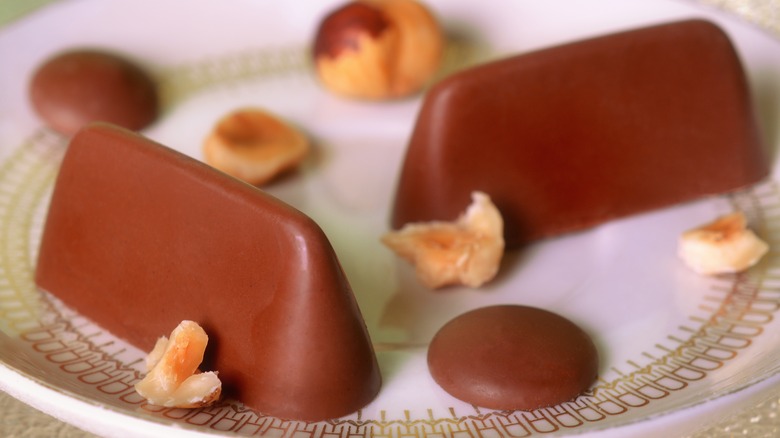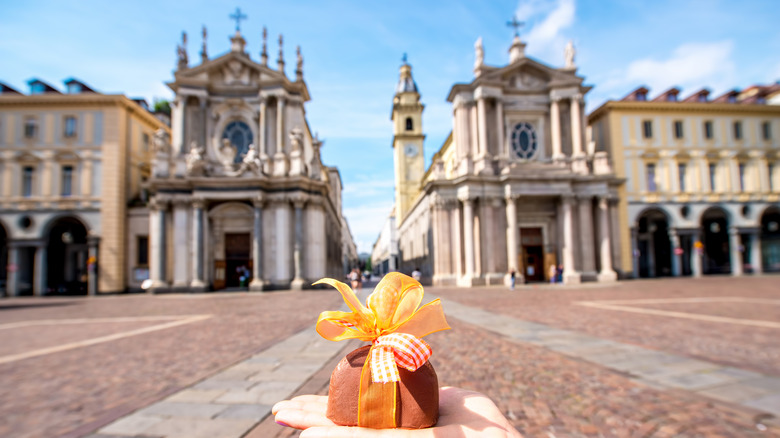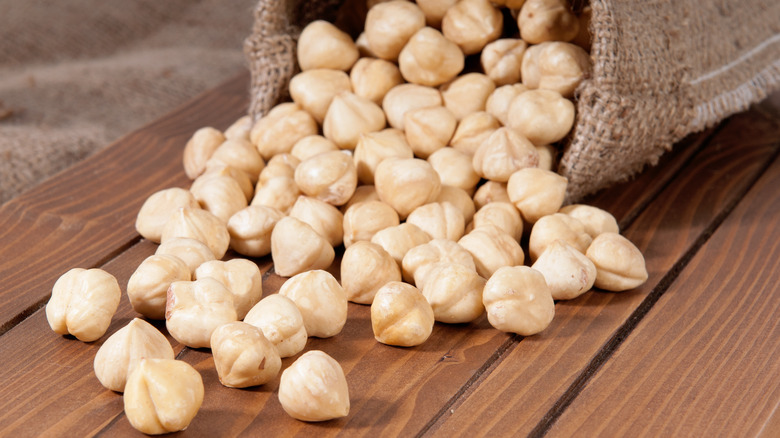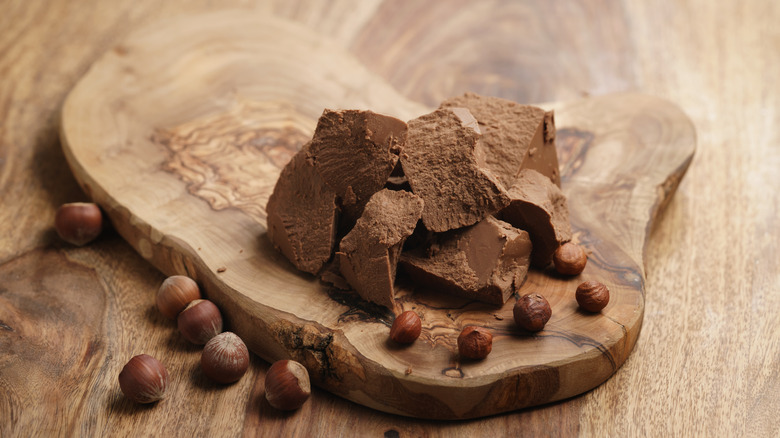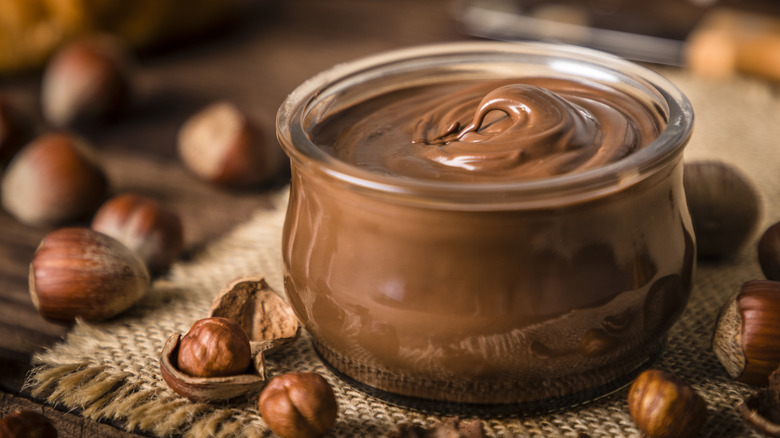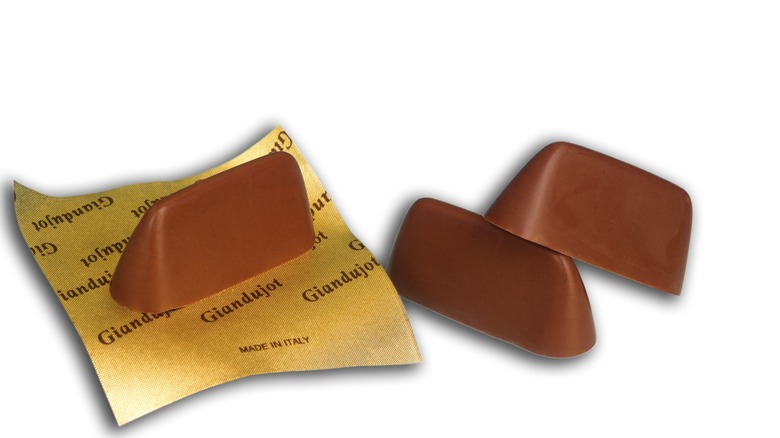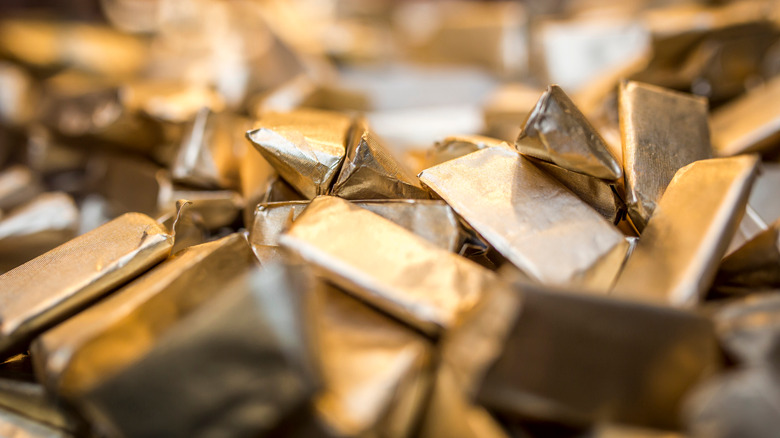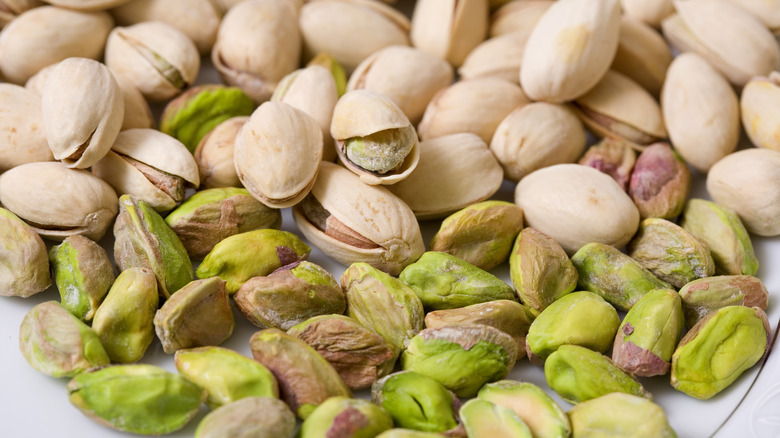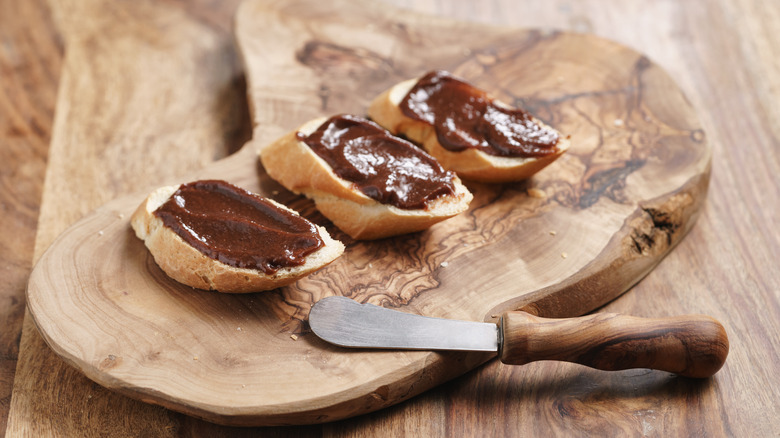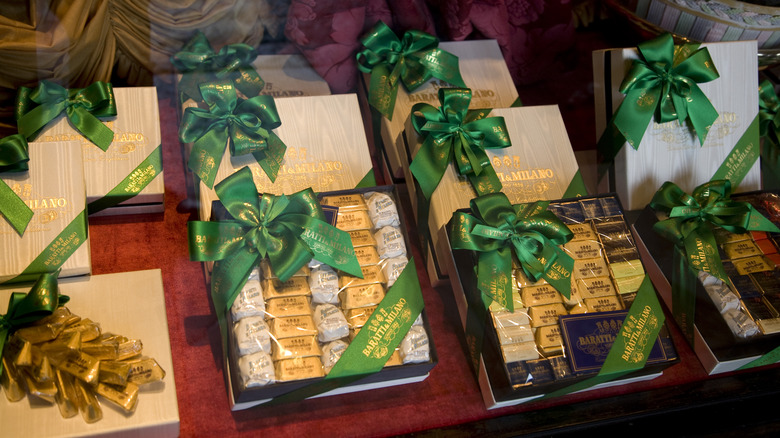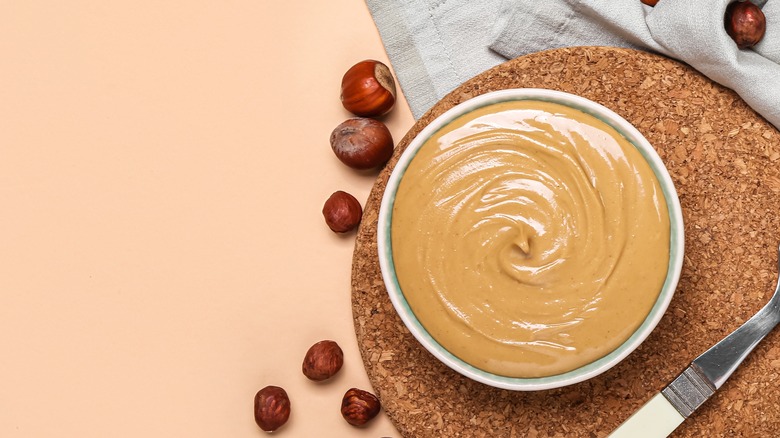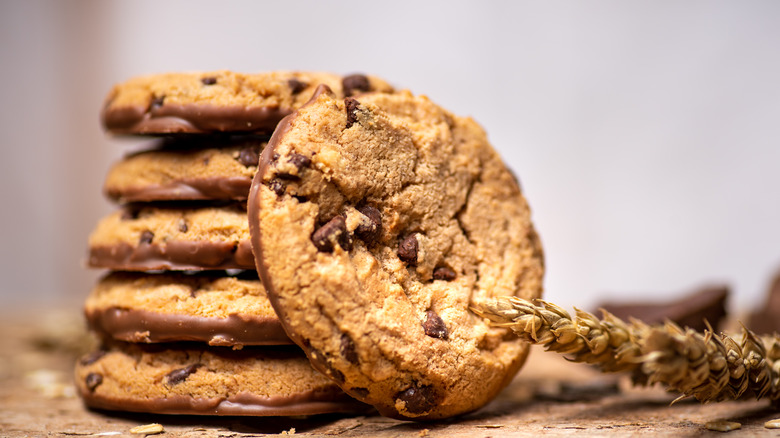Everything You Need To Know About Gianduiotti Chocolate
If you've never tried gianduiotti, your life has been poorer for it. These Italian chocolates are nothing short of a revelation. Often wrapped in gorgeous gold paper, you'll find them all over the place in Italy, from convenience stores to artisan chocolate shops. Although they date back to 19th century Turin, very little has changed about the recipe. I first encountered them as a child when my nonna — my Italian grandma — would send them over in Christmas and birthday packages from Italy. They were always my favorite thing in the package and my love for them has only grown with time.
Anyone who loves Nutella or other chocolate hazelnut confectionery is in for a treat. Gianduiotti (or gianduiotto in the singular) basically taste like Nutella in solid form — except better. You might wonder how much there is to say about one type of chocolate, but gianduiotti have a rich and interesting history. We've got all the information you ever wanted about them and more.
From their history to how they taste to the varieties available today, we've got lots to say about these tasty treats. Once you've finished reading, we guarantee you'll be Googling where you can find them in your area. You can thank us later.
They were invented in Turin, Italy in the 1800s
When you bite into a gianduiotto, there's over 150 years of history behind it. Gianduiotti were invented in the city of Turin in the region of Piedmont in the North of Italy. There are a range of claims about exactly when and by whom they were first made. They seem to be linked to a company called Caffarel that had been crafting chocolate in Turin since the 1820s. Whether or not Cafferel was truly the inventor of gianduiotti, it was the company that first sold to the public during 1865's carnival celebrations in Turin.
Turin already had a booming chocolate industry at this time, having been known for its chocolate since the 1500s. However, at this time, it was rare to find individually wrapped chocolates, so when gianduiotti came on the scene, it was a big deal. The fact they were sold at the carnival celebrations is how they ended up with the name gianduiotti — they were named after a character called Gianduja, whose image is considered Turin's official carnival mask.
The method for making these chocolates spread, and soon other chocolatiers were making them in Turin and eventually beyond. The fact that you can still buy them today and some are made using the same original recipe is a testament to how delicious they are.
Hazelnut is one of the main ingredients
What makes gianduiotti stand out from other chocolates is that they contain a large quantity of hazelnuts in their recipe. But, these aren't whole hazelnuts — rather, the hazelnuts are ground or crushed into a paste. This hazelnut paste is mixed with cocoa mass and sugar to create solid yet melt-in-the-mouth chocolates.
But why hazelnuts? Well, Turin is in the region of Piedmont, which is known for its hazelnuts. In fact, Piedmont hazelnuts are considered some of the best in the world. With this abundant resource nearby, it makes sense that hazelnuts made their way into Turin's confectionery.
While there isn't a mandated minimum percentage of hazelnuts for gianduiotti, it's generally considered that more hazelnuts equals a higher quality product. So, what percentage of hazelnut should you expect? Most mass-produced gianduiotti contain somewhere in the region of 25% to 35% hazelnuts. However, the best handmade gianduiotti contain around 40% hazelnut. This gives you a more richly hazelnutty flavor — and that's a plus. The hazelnuts are roasted, which also contributes to the complexity of flavor.
Their history is filled with myths
Look into the history of gianduiotti and you'll often see one story linked to it. This story states that the creation of gianduiotti was attributed to a shortage of cocoa during the Napoleonic blockade in the early 1800s. During the Napoleonic Wars, the import of certain goods, including cocoa, was prohibited or limited, which left chocolate makers in a quandary. To cope with the scarcity of cocoa, local chocolatiers in Turin started blending chocolate with hazelnuts, which were abundant in the region. This story, however, is likely untrue. While there's certainly truth to the fact that it would have been difficult to import cocoa into the Piedmont region during this time, the dates don't add up. The Napoleonic Wars lasted from 1803 to 1815, but gianduiotti were first sold in 1865.
There's also some question over exactly when and by whom they were invented. One common story is that they were invented by the people at the Caffarel chocolate company and another chocolatier called Michele Prochet in 1852. However, Prochet would only have been 13 at this time, so it seems unlikely. There are also no primary sources to back this up. It's also quite possible that chocolate and hazelnut had been combined in confectionery for some time before gianduiotti were first sold at the 1865 Turin carnival celebrations. So, it may well be that no single person invented these chocolates, but the recipe was simply adapted and improved upon over time.
Gianduiotti taste a lot like Nutella
I have eaten a lot of gianduiotti in my time, and I can confirm that they have a lot in common with Nutella, flavor-wise. This boils down to the fact that Nutella is a spread made from chocolate and hazelnuts (and more), just as gianduiotti are mainly composed of these two key ingredients.
The difference, however, is that gianduiotti taste like elevated Nutella. They contain a much larger percentage of hazelnuts, less sugar, and fewer fillers. Nutella is actually only 13% — it's hefty on the sugar and is bulked out with palm oil. So, you can imagine that gianduiotti have a more refined flavor with their 25% to 40% hazelnut content and simpler ingredient list.
Interestingly, though, Nutella and gianduiotti do have some degree of shared history. Nutella was invented by a pastry chef called Pietro Ferrero, who worked in Piedmont — the same region gianduiotti hail from. When cocoa became harder to come by during World War II, he created a loaf made of hazelnuts, sugar, and the small quantity of cocoa available. Eventually, he turned it into a spreadable paste that he first sold a La Supercrema before changing its name to Nutella.
They're made by multiple brands
Various chocolatiers produce gianduiotti, and you can find them from different brands. We've already mentioned Cafferel, a company that's been producing what it claims to be the original gianduiotti since 1865, but what about other brands?
There are several iconic makers of gianduiotti in different parts of Italy. Established in Turin in 1878, Venchi is a historic Italian chocolate brand known for its premium chocolates, including gianduiotti and other hazelnut-flavored treats. Novi is a chocolate company that produces gianduiotti, among other chocolates. It was founded in 1903 in Novi Ligure, Italy. Then there's Perugina, which started in Perugia, Italy, in 1907, and is known for its gianduiotti, as well as chocolates called Baci.
In addition to the industrial manufacturers, you'll also find small, artisan chocolatiers still making gianduiotti the old-fashioned way by hand in Turin. It's a city that should be on any chocolate lover's travel bucket list.
They come in milk and dark varieties
Gianduiotti are sold in both milk and dark varieties. Although the original recipe wouldn't have contained milk (it wasn't until 1875 that milk chocolate was invented), many recipes today contain a small amount of milk powder to appeal to the mass market. Milk chocolate is generally more popular than dark chocolate, so many folks prefer the less intense flavor of gianduiotti made with milk.
That said, there's a place for the dark chocolate variety, too. With a higher percentage of cocoa, you get a more intensely chocolatey flavor that some people prefer. Not to mention that, without milk, these chocolates are suitable for vegans or the lactose intolerant. But, even in their dark form, you might be surprised that they don't contain milk. The hazelnut paste cuts the chocolate flavor and introduces a creaminess that straight-up dark chocolate doesn't have. The higher the percentage of hazelnut, the richer and creamier you can expect a gianduiotto to be.
You can occasionally find flavored versions
Standard chocolate gianduiotti — whether milk or dark — are the most commonly found options, but you can occasionally find flavored varieties. While these chocolates are tasty enough in their own right that they don't need to be flavored, sometimes it's nice to try out something new.
So, what kinds of flavors are available? Well, Venchi — one popular maker of gianduiotti — crafts pistachio versions. These are quite different from the originals, as Venchi uses pistachio paste instead of hazelnut paste. It also chooses to use cocoa butter instead of cocoa mass, which gives them a white chocolate type finish that pairs beautifully with pistachio.
Some flavored versions still use hazelnuts but add some additional flavored ingredients into the mix. For instance, Turin chocolatier Davide Appendino makes coffee-flavored and white chocolate versions of the classic gianduiotto. Other flavors available include chili and orange. It's worth noting, however, that many of these flavored versions are rare, so you're unlikely to simply stumble upon them, even at an Italian deli or other specialty store.
They're a form of gianduja
Gianduiotti belong to the larger family of gianduja chocolate. Gianduja is a type of chocolate characterized by its smooth texture and distinct flavor, which comes from the combination of chocolate and hazelnuts. As with gianduiotti, it's named after "Gianduja," a traditional carnival character from the region. Gianduiotti is actually the diminutive form of this, meaning little Gianduja. So, the name is saying that these chocolates are a little form of gianduja chocolate.
You can find gianduja chocolate in various forms, including bars, pralines, and spreads. Gianduiotti is one popular manifestation of gianduja chocolate, but it certainly isn't the only one. If you don't want individual pieces of gianduja, you can buy it in large bars or even spread it onto your toast.
Gianduiotti are a specific form of gianduja chocolate, shaped as small triangular prisms, with historical roots in the Piedmont region of Italy. The terms are sometimes used interchangeably, but the name gianduiotti specifically refers to the small, individually wrapped chocolates.
The best gianduiotti are still found in Turin
While you can find mass-produced gianduiotti in many parts of the world, you'll still find many small, artisan producers in Turin, the birthplace of gianduja. The city's rich chocolate tradition, coupled with a commitment to quality and tradition, ensures that Turin is still the place to go if you want to try the finest gianduiotti. Artisan producers in Turin pay homage to the heritage of gianduja, meticulously blending high-quality cocoa with locally sourced hazelnuts to create sublime chocolates.
These small-scale producers, often family-run establishments, adhere to time-honored recipes and techniques. The resulting gianduiotti are like nothing you should find on a grocery store shelf. It's this level of care and attention to detail that distinguishes Turin's gianduiotti from their mass-produced counterparts.
If you find yourself in Turin, there are some places you should definitely head to. Guido Castagna makes some of the best gianduiotti in Turin, using cocoa aged and roasted in-house. A. Giordano is another master chocolatier in Turin, with a shop that's been open since 1897. Here, gianduiotti are made using traditional methods, including being cut and wrapped by hand.
The hazelnuts in them used to be pounded into a paste by hand
The traditional process of making gianduiotti involves a meticulous and labor-intensive step: hand-pounding hazelnuts into a smooth paste. This method, rooted in the historical origins of gianduja in the Piedmont region of Italy, contributes to the unique texture and flavor profile of these iconic chocolates. The hand-pounding of hazelnuts not only incorporated the nut's rich flavor into the chocolate but also imparted a velvety smoothness to the gianduja mixture.
Of course, things aren't the same today and modern production methods involve mechanized processes for efficiency. However, some artisanal chocolatiers in Turin still adhere to the traditional practice of hand-pounding hazelnuts. This commitment to heritage and craftsmanship ensures that the gianduiotti maintain a connection to their historic roots. It offers chocolate enthusiasts a taste of the past and a tribute to the artisanal traditions that make these treats truly special.
These kinds of totally handmade gianduiotti generally don't contain the kinds of stabilizers or preservatives that give them a long shelf life. This means you won't find them for sale far outside Turin or the Piedmont region, so you'll probably have to go a long way to sample them.
You can bake with them — but it might get pricey
Want to do more with your gianduiotti? Why not bake with them? You can add them — whole or chopped — to cake or cookie recipes to add a delicious chocolate hazelnut flavor. Basically, anywhere that you might add chocolate chunks, you could use gianduiotti. It's also possible to melt them for use in recipes that call for melted chocolate.
That said, these chocolates are quite expensive, so you should think carefully about whether the recipe is worth it. If the flavor of the gianduiotti has a chance of getting lost in the recipe, it's better to use some cheaper chocolate. In a vanilla sponge or cookie, however, the chocolate hazelnut taste really comes through. In terms of cost, you might find yourself better off using a gianduja bar rather than individual gianduiotti, though.
In my baking, I've generally reserved them for decoration. I'll never forget a birthday cake I made for my father, who was Italian and loved gianduiotti. It featured a chocolate sponge, chocolate hazelnut frosting, and gianduiotti arranged on top. In this context, they become a luxurious decoration that stands out and makes a celebration cake extra special.
